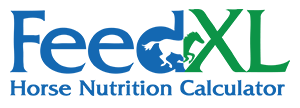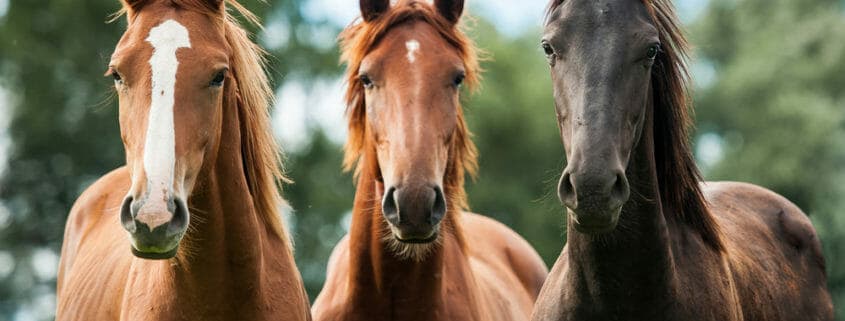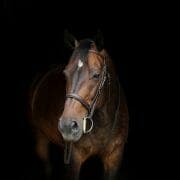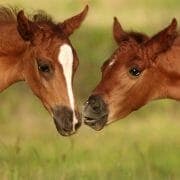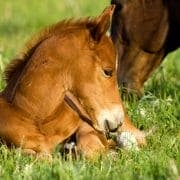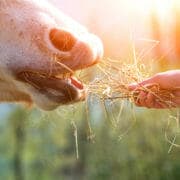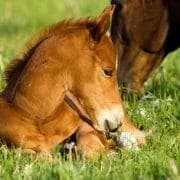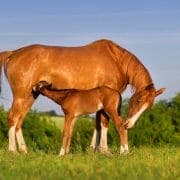Feeding the Weanling
Weanling stage is a critical stage in the growth and development of a horse and nutrition plays a pivotal role. Nutrition as a weanling influences the horse’s final size and perhaps more importantly plays a large role in determining the horse’s long term structural soundness. If you’re wondering what to feed a weanling in your care, you’re in the right place.
As for all horses, a weanling’s energy, protein, mineral and vitamin requirements must be met. This article discusses each of these dietary components in some detail and 3 potential diets for weanlings in different circumstances are given.
Energy
The amount of energy (or calories) you provide in your weanling’s diet is what is going to determine how quickly the weanling grows and how much body condition it is carrying. Growth rate and body condition in weanlings are, in my opinion, the two most important parameters to manage. If you allow your weanling to grow too quickly or carry too much body condition you will put it at increased risk of bone and joint diseases. If the weanling grows too slowly you will potentially end up with a stunted horse that doesn’t reach its genetic potential.
Managing the amount of dietary energy your weanling eats allows you to manage how quickly your weanling is growing and how much body condition it carries. The table below gives you a guide to how much weight a weanling should gain per day (please note these growth rates are for a horse expected to mature at 550 kg).
| Age | Estimated Growth Rate |
|---|---|
| 5 months | 0.8 kg/day |
| 6 months | 0.7 kg/day |
| 7 months | 0.65 kg/day |
| 8 months | 0.6 kg/day |
| 9 months | 0.55 kg/day |
| 10 months | 0.5 kg/day |
| 11 months | 0.45 kg/day |
Maintaining weanling growth rates around these levels will reduce the risk of developmental orthopaedic diseases and ensure your weanling is not being stunted.
A weanling’s body condition should be maintained between 4.5 and 5.5 (on the Henneke System of condition scoring that uses a scale of 1 to 9) and should never be allowed to exceed a condition score of 6 (see FeedXL Newsletter #1 for more information on body condition scores).
If your weanling is growing slower than you would like, the amount of feed (and therefore dietary energy) you are feeding needs to be increased. If your weanling is growing too quickly or is too heavy in condition, the amount of feed (and therefore dietary energy) must be reduced. Growth rates and condition scores are the two parameters that will determine HOW MUCH feed your weanling needs.
You should also be sure to feed sources of dietary energy that are easy for young horses to digest. If you are feeding cereal grains and particularly corn and barley they should be cooked before they are fed (eg extruded, micronised, steam flaked, boiled). Oats doesn’t need to be cooked but it is best fed rolled as many young horses don’t chew oats well enough to be digested. High energy fibres like beet pulp, soy or lupin hulls and copra meal can also be used for weanlings.
Protein
Because a weanling is growing and developing, protein and protein quality are critical in ensuring you are providing all the right building blocks for growth and muscle and bone development. Not providing enough protein, or providing poor quality protein will result in a stunted weanling with poor muscle development. Low protein diets can also contribute to weanlings becoming fat, as they don’t have the building blocks to grow, so instead they lay down all their excess dietary energy as body fat.
High quality forages and particularly alfalfa/lucerne can provide much of a weanling’s daily protein requirement. Where additional supplementary feeds are needed, soybean or soybean-based feeds are the best source of protein for growing horses as they contain high concentrations of the essential amino acids needed for muscle and bone development. Canola meal, lupins and faba beans are also good sources of protein. Cottonseed meal should be avoided as its content and availability of the most limiting amino acid, lysine, is poor.
Many people are scared of feeding protein to their growing horses for fear of causing developmental disease in the bones and joints. Protein DOES NOT cause developmental orthopaedic diseases and restricting protein intake below requirements will stunt growth as well as affect bone and muscle development. Be sure to always meet the protein and lysine requirements given by FeedXL for your weanlings.
Minerals
Minerals play a MAJOR role in determining the future structural soundness of your weanlings. Failure to meet your weanling’s mineral requirements, and particularly calcium, phosphorous, copper, zinc, manganese and sodium means your weanling won’t have the necessary nutrients to build sound bone and cartilage. Deficiencies of other minerals like iodine and selenium can also limit growth rates and contribute
We are yet to see a pasture or hay sample that contains a concentration of these minerals high enough to meet a weanling’s requirements, meaning a weanling will ALWAYS need to be supplemented with minerals at the very least. FeedXL will calculate your weanling’s specific mineral requirements and show you if its diet is or is not meeting those requirements.
Depending on your weanling’s need for additional calories, minerals can be supplemented in the form of a complete feed, where the minerals are mixed in with a sweetfeed/textured feed or pellet or can be fed as a low dose rate mineral supplement or balancer pellet. Weanlings should also always have access to a salt lick.
Vitamins
Vitamins are essential for all horses and weanlings are no exception. Failure to meet vitamin requirements can slow growth rates, affect feed intake and predispose the weanling to infectious diseases. Weanlings grazing green pasture and supplemented with a good quality complete feed, supplement or balancer pellet will generally have their vitamin requirements met. If you are feeding weanlings under drought conditions, particular attention must be paid to their vitamin intake as it is green pasture that usually provides a majority of their vitamin intake.
Again, FeedXL will calculate your weanling’s vitamin requirements and will show you if any deficiencies exist in its current ration.
Example Diets
The following diets are examples of diets that may be used for weanlings 6 months of age weighing 250 kg and growing at 0.8 kg per day (which are parameters typical of a horse that will mature at 550 kg bodyweight).
Diet 1 – Weanling growing too quickly or carrying too much body condition
| 0.5 – 1 kg/day | High Quality Ration Balancer Pellet |
| 300 g/day | Full Fat Soybean |
| Free Choice | Pasture or Hay* and a Plain Salt Lick |
Diet 2 – Weanling growing at the desired rate and in good body condition
| 1.5 – 2 kg/day | Concentrated Complete Feed |
| Free Choice | Pasture or Hay* and salt lick |
Diet 3 – Weanling growing slower than the desired rate (needs a push along)
| 2 – 3.5 kg/day | Complete Feed |
| Free Choice | Pasture or Hay* and salt lick |
* If the pasture or hay is poor quality, feeding 2 kg/day of lucerne hay will lift the overall quality of the forage.
Don’t Hold Them Back
All too often we see young horses underfed because their owner is so petrified of bone disease. The key to growing out sound young horses is to feed a balanced diet, NOT a restricted diet. If you feed correctly to maintain a steady growth rate whilst meeting all of the youngster’s protein, mineral and vitamin requirements, the risk of bone and joint disease is radically reduced. Feeding correctly in the first 12 months of a horse’s life gives you the best chance at having a well grown yet sound horse in the future.
Do you have a question or comment? Do you need help with feeding?
We would love to welcome you to our FeedXL Horse Nutrition Facebook Group. Ask questions and have them answered by PhD and Masters qualified equine nutritionists and spend time with like-minded horse owners. It’s free!
Click here to join the FeedXL Horse Nutrition Facebook Group
